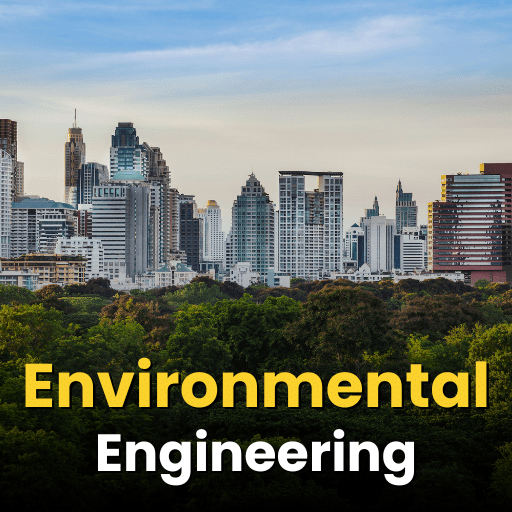Trickling Filter | Environmental Engineering - Civil Engineering (CE) PDF Download
TRICKLING FILTER
- Trickling filter is an attached-growth type of process in which microorganisms attached to a medium are used for removing organic matter from wastewater. that utilizes
- This type of system is common to a number of technologies such as rotating biological contactors (RBCs) and packed bed reactors (biotowers). These reactors are also called as non-submerged fixed film biological reactors.
COMPONENTS OF TRICKLING FILTER
Figure 4.4.1 Trickling filter
[A] Packing
- Trickling filter uses packing medium composed of crushed stone, slag, rock or plastic over which wastewater is distributed continuously (Figure 4.4.1).
- The ideal medium should have the following properties: high specific surface area, high void space, light weight, biological inertness, chemical resistance, mechanical durability, and low cost.
The important characteristics of medium includes-
a) Porosity: It is a measure of the void space available for passage of the wastewater and air and for ventilation of product gases.
b) Specific surface area: It refers to the amount of surface area of the media that is available for biofilms growth.
c) Size of the medium ranges from 50-100 mm having specific surface area in the range of 50-65 m2/m3 with porosities of 40-50 %.
[B] Wastewater dosing
- Influent wastewater is normally applied from the top of the trickling filter. · Under a hydraulic head of about 1.0 m, jet action through the nozzles is sufficient to power the rotor.
- As the flow is intermittent, there is enough air circulation through the pores between dosing.
- The distributer arm distributes the wastewater continuously over the medium, which trickles down through the bed.
[C] Under-drain
- It is used in trickling filters to support the filter medium, collect the treated effluent and the sloughed biological solids, and circulate the air through the filter.
- The liquid flow in under-drains and collection channels should not be more than half full for adequate air flows.
PROCESS DESCRIPTION OF TRICKLING FILTER
- A rotary or stationary distribution mechanism distributes wastewater from the top of the filter percolating it through the interstices of the film-covered medium .
- As the wastewater moves through the filter, the organic matter is adsorbed onto the film and degraded by a mixed population of aerobic microorganisms.
- The oxygen required for organic degradation is supplied by air circulating through the filter induced by natural draft or ventilation.
- As the biological film continues to grow, the microorganisms near the surface lose their ability to cling to the medium, and a portion of the slime layer falls off the filter. This process is known as sloughing .
- The sloughed solids are picked up by the under-drain system and transported to a clarifier for removal from the wastewater.
- Microorganisms used
- The microorganisms used are mainly facultative bacteria that decompose the organic material in the wastewater along with aerobic and anaerobic bacteria.
- It includes Achromobacter, Flavobacterium, Psudomonas, and alcaligenes.
- In the lower reaches of the filter, the nitrifying bacteria are usually present.
FACTORS AFFECTING THE OPERATION OF TRICKLING FILTER
[A] Organic loading
- A high organic loading rate results in a rapid growth of biomass.
- Excessive growth may result in plugging of pores and subsequent flooding of portions of the medium.
[B] Hydraulic flow rates
- Increasing the hydraulic loading rate increases sloughing and helps to keep the bed open. Range of hydraulic and organic loading rates for trickling filters are shown in table 1.
[C] Relative temperature of wastewater and ambient air
- Cool water absorbs heat from air, and the cooled air falls towards toward the bottom of the filter in a concurrent fashion with the water. · Warm water heats the air, causing it to rise through the underdrain and up through the medium.
- At temperature differentials of less than about 3 to 40C, relatively little air movement results, and stagnant conditions prevent good ventilation.
- Extreme cold may result in icing and destruction of the biofilms.
DESIGN EQUATIONS FOR TRICKLING FILTER
[A] Tentative method of ten states of USA
The equation is given as follows:
(4.4.1)
where, Q is the flow rate, R is the recycle flow rate and E is the efficiency.
a) Loading rate
(Raws ettleddomesticsludge)<102kg BOD/(dm3 )
b) R/Q should be such that
BOD entering filter (including recirculat ion) ≤ 3 x BOD expected in effluents
[B] Velz equation
The following equation is used for a single-stage system and in the first stage of a two-stage system:
(4.4.2)
The following equation is used for the second stage of a two-stage system:
(4.4.3)
Where, Se is the effluent BOD from the filter (mg/l), Si is the influent BOD (mg/l), r is the ratio of recirculated flow to wastewater flow, D is the filter depth (m), A is the filter plan area (m2), Q is the wastewater flow (m3/min), T is the wastewater temperature (oC), k and n are empirical coefficients (for municipal wastewaters, k = 0.02 and n = 0.5) and subscript i (i = 1, 2) repressent the stage number.
[C] NRC equations
The following equation is used for a single-stage system and the first stage of a two-stage system:
(4.3.4)
(4.3.5)
The following equation is used for the second stage of a two-stage system:
(4.3.6)
(4.3.7)
[D] Eckenfelder equation (Plastic media)
The Eckenfelder equation used for plastic media is as follows: ..
(4.3.8)
From Eckenfelder equation,
|
14 videos|99 docs|98 tests
|
FAQs on Trickling Filter - Environmental Engineering - Civil Engineering (CE)
| 1. What is a trickling filter? |  |
| 2. How does a trickling filter work? |  |
| 3. What are the advantages of using a trickling filter? |  |
| 4. Are trickling filters effective in treating wastewater? |  |
| 5. How do you maintain a trickling filter? |  |
































